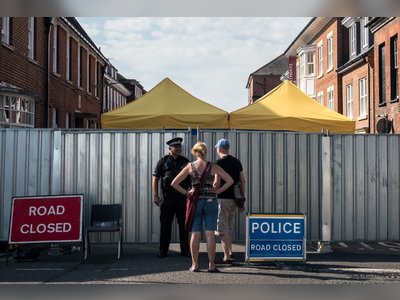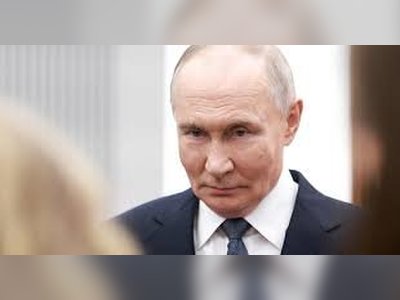Hong Kong protesters' troubling fixation with swastikas
Hong Kong's protestors, demonstrating in their hundreds of thousands to preserve their relative freedoms under China’s "one country, two systems" framework, are constantly searching for a language adequate to their sense of grievance and despair.
But one group of symbols the protestors have adopted are particularly jarring, if not shocking, to outsiders: swastikas and other images taken from the Nazi era.
The vast protests' experimentations in visual language mirror the dissonant identities at the heart of Hong Kong’s travails – and questions about the contemporary repurposing of symbols of historical atrocities.
As a trading port and city-state, situated at a global trading and geopolitical crossroads, the autonomous region of Hong Kong navigates between the legacy of British colonialism and a Chinese culture mediated by almost two centuries of a semi-detached and sometimes fragile co-existence. Since 1997 it has been formally united with China, but on October 1st, Chinese National Day, posters throughout the city called the occasion a "national tragedy."
Hong Kong is also dealing with a change from its self-image as an unstoppable Asian tiger, one of the world’s boom cities of the world in the eighties and nineties, now reeling from an economic decline and diminished economic expectations for the future.
It shouldn’t come as a surprise that for the meme-fluent children of these crisis years, caught between fading British influence and a resurgent China, it is the language of pop culture which they speak with greatest fluency. But while satire and ironic kitsch have proliferated in protest imagery, so has the imagery of the Third Reich. Nazi memes and images more familiar to observers of the American the alt-right, are part of the pop culture references that not only communicate the strength of feeling against China, but also frame the protestors as the evil-taming heroes of a dystopian graphic narrative.
There's been much discussion of the use and reappropriation of the "Pepe the Frog" internet meme, classified as a hate symbol in the U.S. by the Anti-Defamation League for its co-option by the "alt-right," it has emerged as the mascot of the protest movement - as a toy doll, graffiti and even as masks. The major local English language newspaper believes the "weirdness" of his image "provides relief," and protestors charge that they're reclaiming Pepe as a Hongkonger fighting for liberal freedoms.
Hollywood and Japanese anime figures have also been requisitioned everywhere on the streets of Hong Kong. The most ubiquitous is the rebels' slogan from Hunger Games: "If we burn, you burn with us."
Taken from a scene which itself is a movie within a movie (the main character is being filmed for propaganda purposes at the site of a government bombing of rebels) the message is both political and literal: the rebellion is catching fire as the city itself goes up in flames. This has come uncomfortably close to reality during the protests.
During a recent Hong Kong confrontation, on November 11th, when authorities reported a stockpile of over 6,000 petrol bombs and remote control improvised explosive devices. The police, of course, have been using teargas, rubber bullets and water cannon, arbitrary arrests, retaliatory violence and reported sexual assault to contain the protests.
Far outmatched both in gravity and lack of awareness are the casual referencing of motifs and symbols of Nazism. Their use is complex: expressing both fear of China's potential repression, but also the paltry state of Holocaust awareness and education in the Asia Pacific region, along with elements of a disturbing fascination with Nazi Germany.
For months now, protests in Hong Kong have been accompanied by the "Chinazi" flag: Communist China's red flag with its yellow stars rearranged in the shape of a swastika. There's "Chinazi" graffiti all over walls, buildings, even highway surfaces. Even before the Hong Kong protests, China had won comparisons with Nazi Germany, most prominently in the 2018 book, "Nazi China," written by exiled Chinese writer Yu Jie. Protestors have justified using the symbol, claiming there are analogies between China’s internment camps against the Uigyur minority and Nazi concentration camps.
Living in Hong Kong for the last five months, seeing the prevalence of swastikas has been a very dissonant and disturbing experience. Researchers from German universities who work in the city tell me they find the images "inappropriate," and "unacceptable." They're particularly upsetting for local Jews, part of the largest Jewish community in Asia.
As a Holocaust educator and historian of Modern Europe, the repurposing of Nazi symbols has provided me with a surfeit of "teachable moments," all the while wading delicately through a political minefield that includes current-day China and the Chinese experience of WWII.
When I teach the history of the Nazi party, I am always careful to explain the pre-history of the swastika, itself a cultural misappropriation of what had been for centuries a symbol of good fortune in Asian religions. (Confusion is compounded by the fact that the Anglosphere uses the word "swastika," Sanskrit for auspicious, while in German, the Nazi version is more appropriately called a Hakenkreuz, a "chopped cross.")
I recall how discomforting it was when living in India to see my neighbor display a swastika on the doormat to his apartment. But I learnt how in Buddhism it denotes the footprints of the Buddha; in Hinduism it can indicate the four Vedas or seasons, and in Jainism it points to reincarnation. The famed astronomer Carl Sagan, analyzing a manuscript from China's own Han Dynasty, theorized that its origin lay in the ancient sighting of comets.
Adherents of these faith traditions are caught in a quandary, not least in areas where large Jewish and South Asian communities co-exist. They are committed to reclaiming their own ancient symbol, a target of one of history's most notable cultural violations, while recognizing the impact of swastikas as a metonym for Nazism and the contemporary far right. Reproducing the Nazis' appropriation of the swastika, as seen in Hong Kong protestors, does little to help this cause.
Even more ham-fisted are the posters pairing Hong Kong officials with their Nazi "counterparts." Carrie Lam, Hong Kong's Chief Executive since 2017, is visually equalized with Adolf Hitler.
Lo Wai Chung, until recently Hong Kong's Police Commissioner, is equated with Hermann Goering, who pioneered the mass bombing of civilians and gave the order in 1941 to draw up a "final solution to the Jewish question."
In a reductio ad absurdum of Hannah Arendt’s theory of totalitarianism, leading to the undifferentiated and facile equation of Nazism and Stalinism popularized during the Cold War, posters for some anti-China rallies feature both the Chinese flag with swastika and the Soviet hammer and sickle.
In the same vein, in September, some Hong Kong protestors participated in the "Global Anti-Totalitarianism March," set up to mark 80 years since Germany and the Soviet Union divided Poland, reframing it as the "Global Anti-Chinazi March."
However many the faults of the Chinese Leninist state, any kind of historical analogy is simply not supported by even the most basic standards of fact-based evidence - especially not in Hong Kong itself. Nurses are not rewarded with bonuses for reporting on "defective" newborns, whom they later coddle while the babies are administered a lethal poison. Whole families sent to "shower" in gas chambers where for 45 minutes they asphyxiate to death.
As a student of history, I find it particularly baffling that there is hardly any recourse at all to a far more obvious, closer to home reference point for evil: the para-fascistic Empire of Japan during WWII. No protestors reference the regime that mass-administered anthrax and other biological weapons in multiple Chinese regions, while also holding publicized contests of murder to see which individual Japanese soldier could kill the most Chinese at close range.
Wartime Japan had an iconography familiar in Asia that is just as reproducible as Nazi symbols: the rising sun Japanese battle flag, clearly differentiated from today’s national flag, a symbol of unrepentant imperialism, as well as the iconic seated girl symbolic of its enslaved "comfort women."
Even Hong Kong itself equivocates about formally remembering the four long years of the Japanese occupation. In the central district of Wan Chai the building that housed so-called "comfort women," women condemned by the Japanese army to sexual slavery, still stands – but it is the abandoned and unmemorialized, and that lack of tangible commemoration on the occupation is institutional.
To try and bridge the distance between the European Holocaust and Asia, I explain to students that, thanks to a handful of brave Chinese and Japanese consular officials in Europe, Shanghai became the port of last resort for 20,000 of Europe’s Jews, before, during and after the Japanese occupation, who fled there after the November 1938 destruction of the foundations of Jewish communal life in the Nazi Reich - so much so that Shanghai temporarily became a major world center for Viennese psychoanalysis!
It remains an uphill struggle to embed a solid consciousness of the Nazi era and the Holocaust. I prefer not to enumerate the comments, essays and suggestions I received from students to the effect that the Germans were treated "unfairly," and it wasn’t all their fault. It is only the students; even a local history society’s logo features an image of Hitler. Despite there being dozens of Jewish Studies programs and institutes on the Chinese mainland, there is not one at any of Hong Kong’s top 11 institutions of higher education.
Apparently, according to the director of the local Holocaust and Tolerance Center, when Hong Kong students were still under British rule, they were prevented from being taught about Japanese war crimes because the colonial overlords feared it would inflame nationalist sensibilities.
Since the 1997 handover to China, he tells me that students reflexively tune out any such education as just another pro-China nationalist propaganda line straight out of the mainland. And it doesn’t help the general insensitivity to the historical record that the Hong Kong authorities have also played the Nazism exploitation card. Chinese state media have call protesters "Blacknazis," state TV ran an "explanatory video" about their similarities in both Chinese and English, and Chinese state media have likened Hong Kong’s protesters to the perpetrators of, and accomplices to, the Holocaust.
It in such a historical void, in a kind of no-man’s land of identity, by despair at deteriorating conditions and diminished life prospects, by widespread historical ignorance, both of WWII in Europe but also in China that the youth of Hong Kong are left with internet memes, cartoons and swastikas as their homeland of imagination, untethered from their historical weight and from normative taboos . But ignorance is its own pain in and of itself, as the Dalai Lama is want to say: "All suffering is caused by ignorance."
Part of the protestors’ despair and struggle to communicate with less offensive symbols reflects the Hong Kong’s hybrid identity, and its lack of a stable cultural and historical shared vocabulary.
But even so, there is no reason for "Chinazi" imagery to be such an integral part of the cause of civil rights and liberties. In plenty of other places, such as in post-Holocaust Europe, the cause of civil rights and liberties is defended precisely with the elimination of this kind of imagery from the public sphere.












